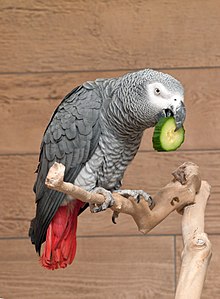Behavior and ecology
Breeding
Grey parrots are monogamous breeders which nest in tree cavities. Each couple of parrots needs its own tree to nest. The hen lays three to five eggs, which she incubates for 30 days while being fed by her mate. The adults defend their nesting sites. Both parents help take care of the chicks until they can go off on their own. Grey parrot chicks require feeding and care from their parents in the nest. The parents take care of them until four or five weeks after they are fledged. Young leave the nest at the age of 12 weeks. Little is known about the courtship behavior of this species in the wild. They weigh 12–14 grams (0.026–0.031 lb) at birth and 372–526 grams (0.820–1.160 lb) when they leave their parents.
Diet
They are mostly frugivorous; most of their diet consists of fruit, nuts, and seeds. The species prefers oil palm fruit and also eat flowers and tree bark, as well as insects and snails. In the wild, the grey is partly a ground feeder. In captivity, it can eat sunflower seeds, bird pellets, a variety of fruits such as pears, orange, pomegranate, apple, and banana, and vegetables such as carrots, cooked sweet potato, celery, fresh kale, peas, and green beans. They also need a source of calciu.
Conservation
The natural predators for this species include palm-nut vultures, as well as a number of raptors; monkeys target eggs and the young for food. Grey parrots in captivity have been observed to be susceptible to fungal infections, bacterial infections, nutritional insufficiency, malignant tumors, psittacine beak and feather disease, tapeworms, and blood-worms.
Humans are by far the largest threat to wild grey populations. Between 1994 and 2003, over 359,000 grey parrots were tradedon the international market. Around 21% of the population of the wild birds are being harvested every year. Mortality rates are extremely high after they are captured until they reach market, ranging from 60–66%. Mortality among imported birds is high. This bird is also hunted for its meat and for its parts which are used in traditional medicines. As a result of the extensive harvest of wild birds, in addition to habitat loss, this species is believed to be undergoing a rapid decline in the wild and has therefore been rated as endangered by the IUCN.
In October 2016, the Convention on the International Trade of Endangered Fauna and Flora (CITES) extended the highest level of protection to grey parrots by listing the species under appendix 1, which bans global and domestic trade in the species.
Relationship to humans
The species is common in captivity and is regularly kept by humans as a companion parrot, prized for its ability to mimic human speech, which makes it one of the most popular avian pets. An escaped pet in Japan was returned to his owner after repeating the owner's name and address.
They are notorious for mimicking noises around their environment and using them tirelessly. While they are highly intelligent birds, they need enrichment and attention in captivity or they can become distressed; feather plucking is a common symptom. They may also be prone to behavioural problems due to their sensitive nature. Social isolation hastens stress and ageing.
Grey parrots are also highly intelligent, having been shown to perform at the cognitive level of a 4- to 6-year-old child in some tasks. New experiments have shown that grey parrots can learn number sequences and can associate human voices with those humans' faces. Most notably, Dr. Irene Pepperberg's work with Alex the parrot showed his ability to learn over 100 words, differentiating between objects, colours, materials, and shapes.
Mutations
Grey mutations occur naturally in the wild, like the Blue Ino (albino), Incomplete Ino, and Blue varietals. The Blue Ino is all white. The Incomplete Ino has light pigmentation. The Blue has a white tail.
Breeders from South Africa, Australia, New Zealand, and Scandinavia have intensively bred greys since the 1800s. These bred varieties include the Red Pied, F2 Pied, Grizzles, Ino, Incomplete, Parino, Lutino, Cinnamon, and Red Factor. South African bird breeder Von van Antwerpen and New Zealand partner Jaco Bosman selected F2 Pieds and created the first Red Factor Greys. The Red Factor Greys are rare, can be predominantly red-pigmented, and range in price depending on the extent of the red plumage displayed.
Credits: Wikipedia
Written by David Davidson




No comments:
Post a Comment